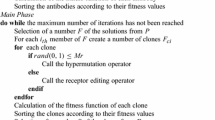Abstract
This paper presents a comparative study of two important Clonal Selection Algorithms (CSAs): CLONALG and opt-IA. To deeply understand the performance of both algorithms, we deal with four different classes of problems: toy problems (one-counting and trap functions), pattern recognition, numerical optimization problems and NP-complete problem (the 2D HP model for protein structure prediction problem). Two possible versions of CLONALG have been implemented and tested. The experimental results show a global better performance of opt-IA with respect to CLONALG. Considering the results obtained, we can claim that CSAs represent a new class of Evolutionary Algorithms for effectively performing searching, learning and optimization tasks.
Preview
Unable to display preview. Download preview PDF.
Similar content being viewed by others
References
Burnet, F.M.: The Clonal Selection Theory of Acquired Immunity. Cambridge University Press, Cambridge (1959)
Cutello, V., Nicosia, G.: The Clonal Selection Principle for in silico and in vitro Computing. In: de Castro, L.N., Von Zuben, F.J. (eds.) Recent Developments in Biologically Inspired Computing (2004)
De Castro, L.N., Timmis, J.: Artificial Immune Systems: A New Computational Intelligence Paradigm. Springer, London (2002)
De Castro, L.N., Von Zuben, F.J.: Learning and optimization using the clonal selection principle. IEEE Trans. on Evolutionary Computation 6(3), 239–251 (2002)
Cutello, V., Nicosia, G., Pavone, M.: Exploring the capability of immune algorithms: A characterization of hypermutation operators. In: Nicosia, G., Cutello, V., Bentley, P.J., Timmis, J. (eds.) ICARIS 2004. LNCS, vol. 3239, pp. 263–276. Springer, Heidelberg (2004)
De Castro, L.N., Timmis, J.: An Artificial Immune Network for Multimodal Function Optimization. In: CEC 2002, Proceeding of IEEE Congress on Evolutionary Computation. IEEE Press, Los Alamitos (2002)
Prugel-Bennett, A., Rogers, A.: Modelling GA Dynamics. In: Proc. Theoretical Aspects of Evolutionary Computing, pp. 59–86 (2001)
Nijssen, S., Back, T.: An analysis of the Behavior of Simplified Evolutionary Algorithms on Trap Functions. IEEE Trans. on Evolutionary Computation 7(1), 11–22 (2003)
Nicosia, G., Cutello, V., Pavone, M., Narzisi, G., Sorace, G.: How to Escape Traps using Clonal Selection Algorithms. In: The First International Conference on Informatics in Control, Automation and Robotics (ICINCO), vol. 1, pp. 322–326. INSTICC Press (2004)
Yao, X., Liu, Y., Lin, G.M.: Evolutionary programming made faster. IEEE Trans. on Evolutionary Computation 3, 82–102 (1999)
Dill, K.A.: Theory for the folding and stability of globular proteins. Biochemistry 24, 1501–1509 (1985)
Crescenzi, P., Goldman, D., Papadimitriou, C., Piccolboni, A., Yannakakis, M.: On the complexity of protein folding. J. of Comp. Bio. 5, 423–466 (1998)
Krasnogor, N., Hart, W.E., Smith, J., Pelta, D.A.: Protein Structure Prediction with Evolutionary Algorithms. In: GECCO 1999, vol. 2, pp. 1596–1601 (1999)
Cutello, V., Morelli, G., Nicosia, G., Pavone, M.: Immune Algorithms with Aging operators for the String Folding Problem and the Protein Folding Problem. In: Raidl, G.R., Gottlieb, J. (eds.) EvoCOP 2005. LNCS, vol. 3448, pp. 80–90. Springer, Heidelberg (2005)
Nicosia, G., Cutello, V., Pavone, M.: An Immune Algorithm with Hyper-Macromutations for the Dill’s 2D Hydrophobic-Hydrophilic Model. In: Congress on Evolutionary Computation, CEC 2004, vol. 1, pp. 1074–1080. IEEE Press, Los Alamitos (2004)
Goldberg, D.E.: The Design of Innovation: Lessons from and for Competent Genetic Algorithms, vol. 7. Kluwer Academic Publisher, Boston (2002)
Cutello, V., Nicosia, G.: An Immunological Approach to Combinatorial Optimization Problems. In: Garijo, F.J., Riquelme, J.-C., Toro, M. (eds.) IBERAMIA 2002. LNCS (LNAI), vol. 2527. Springer, Heidelberg (2002)
Nicosia, G., Cutello, V., Pavone, M.: A Hybrid Immune Algorithm with Information Gain for the Graph Coloring Problem. In: Cantú-Paz, E., Foster, J.A., Deb, K., Davis, L., Roy, R., O’Reilly, U.-M., Beyer, H.-G., Kendall, G., Wilson, S.W., Harman, M., Wegener, J., Dasgupta, D., Potter, M.A., Schultz, A., Dowsland, K.A., Jonoska, N., Miller, J., Standish, R.K. (eds.) GECCO 2003. LNCS, vol. 2723, pp. 171–182. Springer, Heidelberg (2003)
Garrett, S.M.: Parameter-free, Adaptive Clonal Selection. In: Congress on Evolutionary Computing, Portland Oregon (June 2004)
Nicosia, G., Cutello, V., Bentley, P.J., Timmis, J.: Artificial Immune Systems. In: Third International Conference, ICARIS 2004, Catania, Italy, September 13-16, Springer, Heidelberg (2004)
Nicosia, G.: Immune Algorithms for Optimization and Protein Structure Prediction. PHD Thesis, University of Catania, Italy (December 2004)
Cutello, V., Narzisi, G., Nicosia, G.: A Class of Pareto Archived Evolution Strategy Algorithms Using Immune Inspired Operators for Ab-Initio Protein Structure Prediction. In: Rothlauf, F., Branke, J., Cagnoni, S., Corne, D.W., Drechsler, R., Jin, Y., Machado, P., Marchiori, E., Romero, J., Smith, G.D., Squillero, G. (eds.) EvoWorkshops 2005. LNCS, vol. 3449, pp. 54–63. Springer, Heidelberg (2005)
Garrett, S.M.: A Survey of Artificial Immune Systems: Are They Useful? Evolutionary Computation 13(2) (2005) (to appear)
Holland, J.: Genetic algorithms and the optimal allocation of trials. SIAM J. Computing 2, 88–105 (1973)
Holland, J.H.: Adaptation in Natural and Artificial Systems. The University of Michigan Press, Ann Arbor (1975)
Rechenberg, I.: Evolutions strategie: Optimierung Technischer Systeme nach Prinzipien der Biologischen Evolution. Frommann-Holzboog, Stuttgart (1973)
Fogel, L.J., Owens, A.J., Walsh, M.J.: Artificial Intelligence Through Simulated Evolution. Wiley Publishing, New York (1966)
Koza, J.R.: Evolving a computer program to generate random numbers using the genetic programming paradigm. In: Proc. of the Fourth Int. Conf. on GA (1991)
Author information
Authors and Affiliations
Editor information
Editors and Affiliations
Rights and permissions
Copyright information
© 2005 Springer-Verlag Berlin Heidelberg
About this paper
Cite this paper
Cutello, V., Narzisi, G., Nicosia, G., Pavone, M. (2005). Clonal Selection Algorithms: A Comparative Case Study Using Effective Mutation Potentials. In: Jacob, C., Pilat, M.L., Bentley, P.J., Timmis, J.I. (eds) Artificial Immune Systems. ICARIS 2005. Lecture Notes in Computer Science, vol 3627. Springer, Berlin, Heidelberg. https://doi.org/10.1007/11536444_2
Download citation
DOI: https://doi.org/10.1007/11536444_2
Publisher Name: Springer, Berlin, Heidelberg
Print ISBN: 978-3-540-28175-7
Online ISBN: 978-3-540-31875-0
eBook Packages: Computer ScienceComputer Science (R0)




